- “Empowering Emergency Medicine Physicians”
- “Queue Management Software and Hospitalists in Modern Healthcare”
- “Enhancing-Pediatric-Infectious-Disease-Care”
- “Revolutionizing-Geriatric-Care”
- “Optimizing-Patient-Care-in-Pediatric-Rheumatology”
- “Pediatric-Pulmonology-Care”
- “Revolutionizing-Pediatric-Gastroenterology”
- “Enhancing-Pediatric-Neurology-Care”
- “Optimizing-Pediatric-Cardiology”
- “Enhancing-Pediatric-Endocrinology-Care”
- “Empowering-Neonatologists-with-EMR-Software”
- “Pediatrics-in-Focus”
- “Empowering-Neurologists-with-Electronic-Prescriptions”
- “Streamlining-Dermatology-Practice”
- “Streamlining-Psychiatry-Practice”
- “A-Game-Changer-for-Infectious-Disease-Specialists”
- “Allergist/Immunologist-Practices-with-QME-EMR-and-Hospital-Management-Systems”
- “Empowering-Hematologists-and-Revolutionizing-Healthcare-Management”
- “Optimizing-Healthcare-with-HMIS”
- “Transforming-Healthcare-with-Endocrinologist”
- “Healthcare-Management-with-QMe-EMR-for-Nephrologists”
- “Revolutionizing-Healthcare-Management-with-Cardiologist”
- “Streamlining-Operations-with-Queue-Management-Software”
- “Optimizing-Healthcare-Delivery”
- “Transforming-Healthcare-Management”
- HMIS And Decision Support Systems
- Dengue Unveiled: An Overview of Causes, Symptoms, and Prevention.
- Dengue Fever: Unraveling the Mosquito-Borne Menace.
- HMIS-and-Continuity-of-Care
- Project-Management-for-Successful-HMIS
- Catalysts of Wellness: The Transformative Power of Diagnosis and Screening in Healthcare
- Patient-Data-Management
- Guardians of Healthcare: The Vital Role of Fraud Detection in Ensuring Ethical Care
- Unlocking Insights
- Healthcare in the Digital Age: The History Of Development Of HMIS
- Transforming Healthcare
- Safeguarding-HMIS-Data
- HMIS-Integration-Challenges
- ANXIETY UNVEILED: CONQUERING FEARS AND CULTIVATING CALM.
- BEYOND THE BLUE: EMBRACING LIGHT ON THE PATH OF DEPRESSION.
- BEYOND THE BLUE: EMBRACING LIGHT ON THE PATH OF DEPRESSION.
- HMIS and Resource Allocation
- HMIS Data Accuracy and Integrity
- SOOTHING THE SILENT PAIN: UNDERSTANDING VULVODYNIA.
- Impact of HMIS on OPD Operations
- In Patient Management Through Health Management
- WITHIN THE SHADOWS: UNDERSTANDING BRAIN TUMOURS FROM WITHIN
- HMIS-and-Health-Insurance-Integration
- HMIS-Data-Analytics-for-Preventive-Care
- SILENT INTRUDERS: UNRAVELLING THE MYSTERIES OF PELVIC INFLAMMATORY DISEASE
- BREAKING FREE: OVERCOMING THE HURDLE OF URINARY INCONTINENCE
- “HMIS and Doctor-Patient Communication”
- HEALING INSIGHTS: THE POWER OF THE HOSPITAL MANAGEMENT INFORMATION SYSTEM.
- SOLVING THE OVARIAN PUZZLE:UNDERSTANDING OVARIAN CYST INSIDE OUT
- Usability And User Experience In HMIS
- POLYCYSTIC OVARY PUZZLE: UNRAVELLING THE ENIGMA OF PCOS
- Unlocking-the-Potential-of-HMIS-Data-for Medical-Research-and-Healthcare-Policy-Enhancement
- Feminine Health Unplugged: Empowering Women in Vaginal Infection Awareness
- Revitalizing Feminine Comfort: A Journey Through Vaginal Wellness.
- HMIS Vendor Selection Guide
- UNDERSTANDING FIBROIDS: NAVIGATING THE INTRICACIES OF UTERINE HEALTH.
- Best Practices for Data Migration in Healthcare Management Information Systems (HMIS)
- CONCEIVING HOPE: NAVIGATING THE JOURNEY OF INFERTILITY
- MENSTRUAL IRREGULARITIES: CAUSES AND TREATMENT
- RISING ABOVE: EMPOWERING WOMEN WITH PELVIC ORGAN PROLAPSE
- Leveraging HMIS for Enhanced Public Health Management and Disease Surveillance
- Challenges and Benefits of Implementing HMIS in Rural and Remote Healthcare Settings
- Securing Healthcare Continuity
- Pancreatic Cancer
- Lymphoma
- Leukemia
- Bladder Cancer
- Skin Cancer (Melanoma)
- COLORECTAL CANCER
- All about Prostate Cancer
- Fighting out the Disease of Lung Cancer
- Advances in Breast Cancer Treatment: A Comprehensive Guide
- Autism Spectrum Disorder (ASD)
- EHR SYMPHONY: HARMONIZING HEALTHCARE THROUGH ELECTRONIC RECORDS .
- Understanding Testicular Cancer: Detection, Treatment And Awareness.
- Childhood Obesity
- Kawasaki Disease
- Eczema (Atopic Dermatitis)
- Understanding Bone Cancer: A Brief Overview.
- Virtual Healing: Navigating Healthcare Through Telemedicine and Telehealth.
- Attention-Deficit/Hyperactivity Disorder (ADHD)
- PELVIC PAIN:CAUSES SYMPTOMS AND PREVENTIONS
- Type 1 Diabetes: Causes, Symptoms, and Treatment
- Gastroesophageal Reflux Disease (GERD)
- Battling Pneumonia: Unveiling the Stealthy Invader of the Lungs
- Unravelling the Complexity of Allergic Reactions: Understanding, Managing, and Thriving
- Rashes (Eczema, Dermatitis)
- UNDERSTANDING CERVICAL DYSPLASIA: CAUSES, SYMPTOMS AND MANAGEMENT
- Chicken Pox
- Endometriosis Unmasked: A Closer Look at the Silent Struggle
- Croup
- Hand, Foot and Mouth Disease (HFMD)
- THE DAWNING OF A NEW ERA: EMBRACING THE JOURNEY OF MENOPAUSE
- Urinary Tract Infections (UTIs)
- Strep Throat (Streptococcal Pharyngitis)
- Understanding Otitis Media(Ear Infection)
- 28th July In medical history!!
- Influenza (Flu) - Symptoms, Prevention and Management
- 27th July In medical history!!
- Respiratory Syncytial Virus (RSV) Infection
- SIGNIFICANCE AND ADVANTAGES OF HMIS: A DETAILED ANALYSIS
- Beyond Boundaries: Transforming Healthcare with Virtual Reality
- TRACK YOUR LIFE : A DETAILED UNDERSTANDING ON HEALTH MONITORING SYSTEM
- EXPLORING BENEATH THE SURFACE: UNDERSTANDING BARTHOLIN CYSTS AND ABSCESSES
- GUARDING GUT HEALTH: YOUR GUIDE TO POTENTIAL CROHN’S DISEASE PREVENTION.
- PATHWAYS OF HOPE: NAVIGATING THE CHALLENGES OF ESOPHAGEAL CANCER
- Gastric Battles: Confronting Stomach Cancer Head-On.
- HMIS IN SMALL CLINICS: A STEP TO A BETTER FUTURE
- Harmonizing Your Cycle: A Journey to Menstrual Health and Balance.
- Respiratory Syncytial Virus (RSV) Infection
- GUARDING OUR INTIMATE WORLD: A CLOSER LOOK AT STI
- Real-World HMIS Implementation Case Studies: Using Data to Transform Healthcare
- Gastroenteritis (Stomach Flu)
- Asthama - The Anatomy Of Breathing
- Influenza - A Silent Intruder
- Breast Cancer
WARRIOR’S BATTLE: TRIUMPHING OVER UTERINE CANCER
WARRIOR’S BATTLE: TRIUMPHING OVER UTERINE CANCER
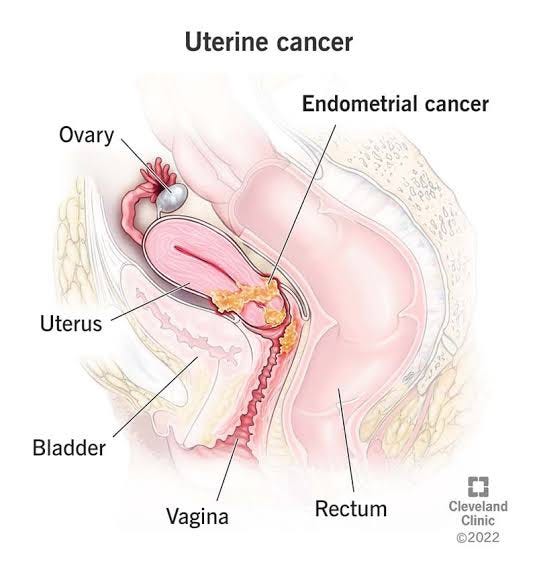
Uterine cancer, also known as endometrial cancer, is a type of cancer that develops in the lining of the uterus, called the endometrium. It occurs when cells in the endometrium grow uncontrollably, leading to the formation of a tumor. Uterine cancer is one of the most common gynecological cancers in women and can be detected through symptoms like abnormal vaginal bleeding, pelvic pain, or changes in urination. Prompt diagnosis and appropriate treatment are essential for managing the condition effectively.
CAUSES LEADING TO UTERINE CANCER
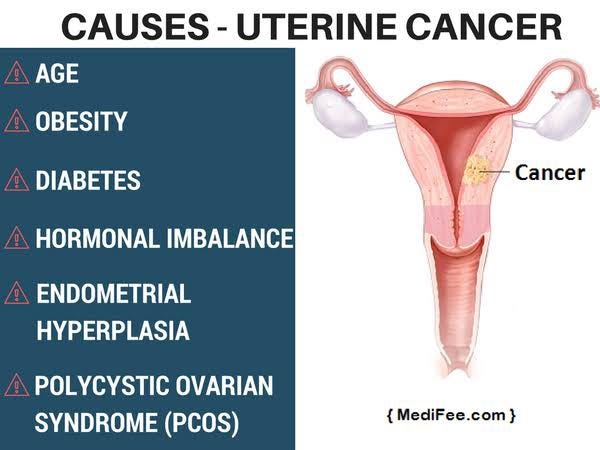
The exact causes of uterine cancer are not always clear, but certain factors can increase the risk of developing the disease. Here are some potential causes and risk factors:
-
Hormonal imbalances: An excess of estrogen without sufficient progesterone can lead to an overgrowth of the uterine lining, increasing the risk of cancer.
-
Age: Uterine cancer is more common in postmenopausal women, usually between the ages of 50 and 60.
-
Obesity: Being overweight or obese is linked to higher levels of estrogen, which can contribute to the development of uterine cancer.
-
Hormone therapy: Prolonged use of estrogen-only hormone replacement therapy (HRT) without progesterone increases the risk.
-
Diabetes: Women with diabetes have a higher risk of uterine cancer due to insulin resistance and high insulin levels.
-
Polycystic ovary syndrome (PCOS): This condition can cause hormonal imbalances and increase the risk of uterine cancer.
-
Hereditary factors: A family history of uterine cancer or certain genetic conditions, like Lynch syndrome, can raise the risk.
-
Personal history of breast or ovarian cancer: Women with a history of these cancers may have an increased risk of uterine cancer.
-
Tamoxifen: Long-term use of tamoxifen, a medication used for breast cancer treatment, can raise the risk of uterine cancer.
-
Radiation therapy: Past pelvic radiation treatment can increase the likelihood of developing uterine cancer.
It’s essential to note that having one or more of these risk factors does not guarantee the development of uterine cancer, and individuals without these risk factors can still develop the disease. Regular check-ups and early detection can significantly improve the chances of successful treatment and outcomes. If you have concerns about uterine cancer, it’s best to speak with a healthcare professional. Keeping that in mind, QMe is a cutting-edge hospital management software designed to revolutionize healthcare facilities worldwide. With its intelligent queue-based OPD management system, patients experience reduced waiting times and optimized appointment scheduling. The software’s comprehensive patient history and electronic health records ensure seamless access to critical medical information, enabling healthcare professionals to make informed decisions and provide personalized care. QMe’s automatic workflows streamline administrative tasks and treatment plans, enhancing overall efficiency and reducing human errors. The software’s IPD management feature enables smooth inpatient care coordination, while its TPA support simplifies insurance processes.
SPOTTING THE SIGNS OF UTERINE CANCER
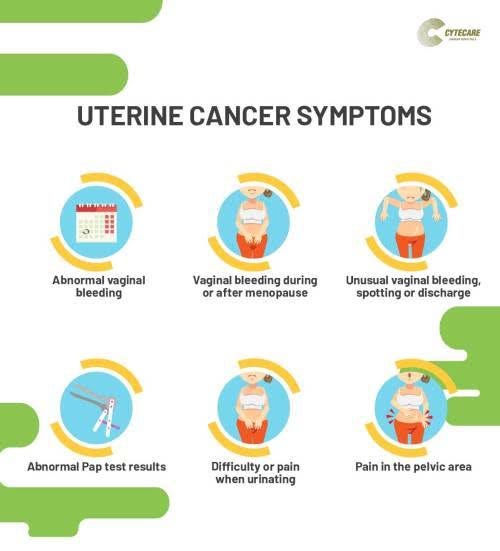
The symptoms of uterine cancer can vary, and some women may not experience any symptoms in the early stages. However, common signs and symptoms of uterine cancer may include:
-
Abnormal vaginal bleeding: Postmenopausal bleeding or any abnormal bleeding between periods, heavier periods, or bleeding after intercourse.
-
Pelvic pain or discomfort: Persistent pain in the pelvic area or lower abdomen.
-
Painful urination: Experience pain or discomfort while urinating.
-
Unexplained weight loss: Sudden and unexplained weight loss without any apparent reason.
-
Changes in bowel habits: Changes in bowel movements or persistent diarrhea or constipation.
-
Feeling of fullness: A sensation of fullness or bloating in the abdomen.
-
Fatigue: Unexplained tiredness or lack of energy.
It’s crucial to remember that these symptoms can also be caused by various other conditions not related to cancer. However, if you experience any of these symptoms, especially postmenopausal bleeding or persistent pelvic pain, it’s essential to consult a healthcare professional for proper evaluation and diagnosis. Early detection and timely treatment can improve the chances of successful management of uterine cancer. Additionally, QMe offers packages support for various medical services and features automated billing to ensure transparent and hassle-free financial transactions. Embracing QMe empowers hospitals to enhance patient experiences, optimize healthcare workflows, and deliver top-notch medical services.
TREATING THE TROUBLE
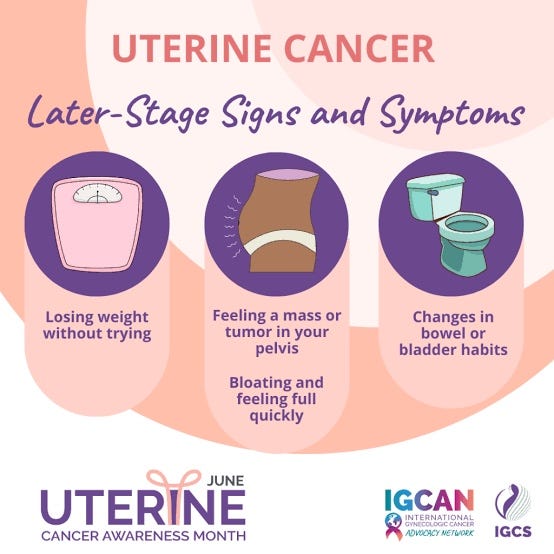
The treatment for uterine cancer depends on various factors, including the stage and type of cancer, as well as the individual’s overall health. In addition to surgical interventions and radiation therapy, medications may also be used in the management of uterine cancer. Some common medications used in uterine cancer treatment include:
-
Hormonal therapy: Hormone therapy is used for certain types of uterine cancer that are hormone-sensitive. Drugs like progestins or tamoxifen may be prescribed to block estrogen’s effects or regulate hormone levels.
-
Chemotherapy: Chemotherapy involves the use of drugs to kill cancer cells or stop their growth. It is often used in advanced stages of uterine cancer or when the cancer has spread to other parts of the body.
-
Targeted therapy: Targeted therapies are drugs that specifically target cancer cells’ specific characteristics, minimizing damage to healthy cells. They can be used in specific cases of advanced or recurrent uterine cancer.
-
Immunotherapy: Immunotherapy helps the body’s immune system to recognize and attack cancer cells. Some immunotherapies are being studied for use in uterine cancer treatment.
The choice of medication and treatment plan will be determined by a healthcare team, including oncologists and other specialists, based on the individual’s specific condition and medical history. It’s essential to discuss treatment options and potential side effects with your healthcare provider to make informed decisions about the best approach for your situation.
The treatment of uterine cancer depends on several factors, including the stage of cancer, the type of cancer, the overall health of the individual, and their personal preferences. The primary treatment options for uterine cancer include:
-
Surgery: Surgical removal of the uterus (hysterectomy) is the most common treatment for uterine cancer. In some cases, the surgeon may also remove the surrounding tissues and nearby lymph nodes. This procedure aims to remove the cancerous tissue and reduce the risk of recurrence.
-
Radiation therapy: Radiation therapy uses high-energy beams to target and destroy cancer cells. It may be used before surgery (neoadjuvant therapy) to shrink the tumor or after surgery (adjuvant therapy) to kill any remaining cancer cells.
-
Chemotherapy: Chemotherapy involves the use of drugs to kill cancer cells or stop their growth. It is typically used in advanced stages of uterine cancer or if the cancer has spread to other parts of the body.
-
Hormonal therapy: For certain types of uterine cancer that are hormone-sensitive, hormonal therapy may be used. This treatment involves the use of hormones or hormone-blocking drugs to slow down the growth of cancer cells.
-
Targeted therapy: Targeted therapies are drugs that specifically target certain characteristics of cancer cells, minimizing damage to healthy cells. They may be used in specific cases of advanced or recurrent uterine cancer.
-
Immunotherapy: Immunotherapy helps the body’s immune system to recognize and attack cancer cells. Some immunotherapies are being studied for use in uterine cancer treatment.
The treatment plan will be determined by a multidisciplinary team of healthcare professionals, including oncologists, surgeons, and radiation specialists. They will consider various factors and work with the individual to create a personalized treatment approach that offers the best chance of effectively managing the uterine cancer. Regular follow-up and monitoring are also essential to track the response to treatment and detect any potential recurrence. Additionally, QMe offers packages support for various medical services and features automated billing to ensure transparent and hassle-free financial transactions. Embracing QMe empowers hospitals to enhance patient experiences, optimize healthcare workflows, and deliver top-notch medical services.
HYSTERECTOMY

A hysterectomy is a surgical procedure that involves the removal of the uterus. It is one of the most common surgical treatments for various gynecological conditions, including uterine cancer, fibroids, endometriosis, and certain types of pelvic organ prolapse.
There are different types of hysterectomy procedures, including:
-
Total hysterectomy: In this procedure, the entire uterus, including the cervix, is removed.
-
Partial (subtotal) hysterectomy: Only the upper part of the uterus is removed, leaving the cervix intact.
-
Radical hysterectomy: This is an extensive surgery that involves the removal of the uterus, surrounding tissues, parts of the vagina, and nearby lymph nodes. It is primarily used for certain cases of advanced cervical or uterine cancer.
Hysterectomy is considered a major surgery, and it can be performed through various approaches, including abdominal, vaginal, or laparoscopic methods. Recovery time and post-operative care may vary depending on the type of hysterectomy and the individual’s overall health.
Before undergoing a hysterectomy, it’s essential for the individual to have a detailed discussion with their healthcare provider about the reasons for the procedure, potential risks, and expected outcomes. Hysterectomy is a significant decision, and alternatives or less invasive treatments may be considered depending on the individual’s specific medical condition and preferences.
RADIATION THERAPY
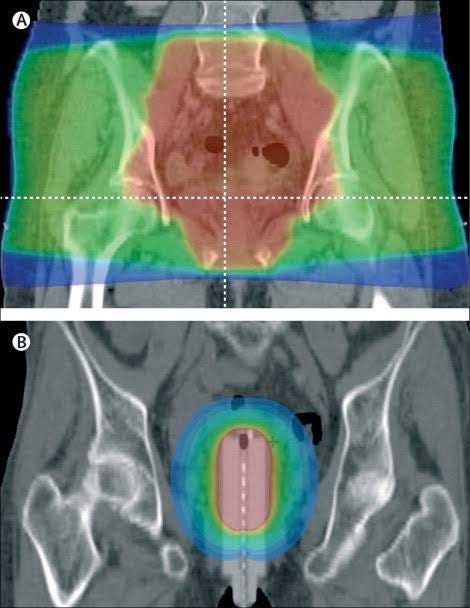
Radiation therapy is a common treatment for cancer, including uterine cancer. It uses high-energy beams, such as X-rays or protons, to target and destroy cancer cells in the affected area. The main goal of radiation therapy is to damage the DNA inside cancer cells, preventing them from growing and dividing, thus leading to their death.
There are two primary types of radiation therapy used in uterine cancer treatment:
-
External beam radiation therapy (EBRT): This involves directing radiation beams from outside the body towards the cancer site. It is a non-invasive procedure that is usually given as outpatient treatment over several weeks.
-
Internal radiation therapy (brachytherapy): In this type of radiation therapy, a radioactive source is placed inside the uterus, near the cancerous tissue. Brachytherapy allows for a higher dose of radiation to be delivered directly to the tumor while sparing nearby healthy tissues.
Radiation therapy may be used as the primary treatment for early-stage uterine cancer, either alone or in combination with surgery. It can also be used after surgery (adjuvant therapy) to kill any remaining cancer cells and reduce the risk of recurrence. For more advanced cases or when cancer has spread beyond the uterus, radiation therapy may be used along with other treatments like chemotherapy or hormonal therapy.
As with any cancer treatment, radiation therapy may cause side effects, which can vary depending on the type and dose of radiation, the treated area, and the individual’s overall health. Common side effects may include fatigue, skin irritation, nausea, and changes in bowel or bladder function. Healthcare providers work closely with patients to manage side effects and ensure the best possible outcomes during radiation therapy.
CHEMOTHERAPY

Chemotherapy is a systemic treatment used to treat various types of cancer, including uterine cancer. Unlike surgery or radiation therapy that targets specific areas, chemotherapy involves the use of powerful drugs that circulate throughout the body to destroy cancer cells wherever they may be located.
Chemotherapy drugs work by interfering with the cancer cells’ ability to grow and divide, ultimately leading to their death. The treatment is usually given in cycles, with a period of rest between each cycle to allow the body to recover from the effects of the drugs.
Chemotherapy may be used in different ways for uterine cancer treatment
-
Adjuvant chemotherapy: After surgery, adjuvant chemotherapy may be given to kill any remaining cancer cells and reduce the risk of recurrence.
-
Neoadjuvant chemotherapy: In some cases, chemotherapy may be given before surgery to shrink the tumor, making it easier to remove.
-
Palliative chemotherapy: For advanced or recurrent uterine cancer, chemotherapy may be used to control the disease, relieve symptoms, and improve the quality of life.
Chemotherapy is associated with various side effects, which can vary depending on the drugs used and the individual’s response. Common side effects may include fatigue, hair loss, nausea, vomiting, and an increased risk of infection. Healthcare providers work closely with patients to manage side effects and provide supportive care during chemotherapy. The choice of chemotherapy drugs and the treatment plan is determined by a healthcare team, including oncologists and other specialists, based on the individual’s specific condition and medical history. As with any cancer treatment, it’s essential to discuss the potential benefits and risks of chemotherapy with your healthcare provider
PREVENTATIVE MEASURES
To prevent uterine cancer, consider the following measures:
-
Maintain a healthy weight: Obesity is a significant risk factor for uterine cancer, so aim to maintain a healthy weight through a balanced diet and regular physical activity.
-
Regular exercise: Engage in regular physical activity as it is associated with a reduced risk of uterine cancer. Strive for at least 150 minutes of moderate-intensity exercise or 75 minutes of vigorous-intensity exercise per week.
-
Limit hormone therapy: If you require hormone replacement therapy (HRT), discuss the lowest effective dose with your healthcare provider to minimize the risk of uterine cancer.
-
Birth control pills: The use of oral contraceptives (birth control pills) may reduce the risk of uterine cancer. Discuss the potential benefits and risks with your healthcare provider.
-
Regular check-ups and screenings: Attend regular gynecological check-ups and screenings to monitor your health and detect any potential issues early.
-
Be aware of symptoms: Familiarize yourself with the signs and symptoms of uterine cancer, such as abnormal vaginal bleeding, pelvic pain, or changes in urination, and seek medical attention if you experience any concerning symptoms.
-
Genetic counseling: If you have a family history of uterine cancer or other related cancers, consider genetic counseling to assess your risk and discuss preventive measures.
Remember that no single measure can guarantee the prevention of uterine cancer, and some risk factors may be beyond your control, such as age and genetic predisposition. However, adopting a healthy lifestyle and staying proactive with regular check-ups can contribute to overall well-being and reduce the risk of developing various health conditions, including uterine cancer. If you have concerns about uterine cancer or your risk factors, consult with a healthcare professional for personalized advice and guidance.
CONCLUSION
In conclusion, uterine cancer, also known as endometrial cancer, is a type of cancer that develops in the lining of the uterus. Early detection and proper treatment are crucial for managing the disease effectively. If you experience symptoms such as abnormal vaginal bleeding, pelvic pain, or changes in urination, it’s essential to seek medical attention promptly.
Prevention plays a vital role in reducing the risk of uterine cancer. Maintaining a healthy weight, engaging in regular physical activity, and limiting hormone therapy are some preventive measures to consider. Additionally, staying proactive with regular check-ups and screenings can help in detecting any potential issues early.
Remember that each individual’s risk factors and medical history may vary, so it’s essential to work with healthcare professionals to assess your specific risk and create a personalized prevention and treatment plan.
If you have concerns about uterine cancer or any other health-related questions, don’t hesitate to reach out to your healthcare provider for guidance and support. Taking proactive steps towards your health can lead to better outcomes and an improved quality of life.
- “Empowering Emergency Medicine Physicians”
- “Queue Management Software and Hospitalists in Modern Healthcare”
- “Enhancing-Pediatric-Infectious-Disease-Care”
- “Revolutionizing-Geriatric-Care”
- “Optimizing-Patient-Care-in-Pediatric-Rheumatology”
- “Pediatric-Pulmonology-Care”
- “Revolutionizing-Pediatric-Gastroenterology”
- “Enhancing-Pediatric-Neurology-Care”
- “Optimizing-Pediatric-Cardiology”
- “Enhancing-Pediatric-Endocrinology-Care”
- “Empowering-Neonatologists-with-EMR-Software”
- “Pediatrics-in-Focus”
- “Empowering-Neurologists-with-Electronic-Prescriptions”
- “Streamlining-Dermatology-Practice”
- “Streamlining-Psychiatry-Practice”
- “A-Game-Changer-for-Infectious-Disease-Specialists”
- “Allergist/Immunologist-Practices-with-QME-EMR-and-Hospital-Management-Systems”
- “Empowering-Hematologists-and-Revolutionizing-Healthcare-Management”
- “Optimizing-Healthcare-with-HMIS”
- “Transforming-Healthcare-with-Endocrinologist”
- “Healthcare-Management-with-QMe-EMR-for-Nephrologists”
- “Revolutionizing-Healthcare-Management-with-Cardiologist”
- “Streamlining-Operations-with-Queue-Management-Software”
- “Optimizing-Healthcare-Delivery”
- “Transforming-Healthcare-Management”
- HMIS And Decision Support Systems
- Dengue Unveiled: An Overview of Causes, Symptoms, and Prevention.
- Dengue Fever: Unraveling the Mosquito-Borne Menace.
- HMIS-and-Continuity-of-Care
- Project-Management-for-Successful-HMIS
- Catalysts of Wellness: The Transformative Power of Diagnosis and Screening in Healthcare
- Patient-Data-Management
- Guardians of Healthcare: The Vital Role of Fraud Detection in Ensuring Ethical Care
- Unlocking Insights
- Healthcare in the Digital Age: The History Of Development Of HMIS
- Transforming Healthcare
- Safeguarding-HMIS-Data
- HMIS-Integration-Challenges
- ANXIETY UNVEILED: CONQUERING FEARS AND CULTIVATING CALM.
- BEYOND THE BLUE: EMBRACING LIGHT ON THE PATH OF DEPRESSION.
- BEYOND THE BLUE: EMBRACING LIGHT ON THE PATH OF DEPRESSION.
- HMIS and Resource Allocation
- HMIS Data Accuracy and Integrity
- SOOTHING THE SILENT PAIN: UNDERSTANDING VULVODYNIA.
- Impact of HMIS on OPD Operations
- In Patient Management Through Health Management
- WITHIN THE SHADOWS: UNDERSTANDING BRAIN TUMOURS FROM WITHIN
- HMIS-and-Health-Insurance-Integration
- HMIS-Data-Analytics-for-Preventive-Care
- SILENT INTRUDERS: UNRAVELLING THE MYSTERIES OF PELVIC INFLAMMATORY DISEASE
- BREAKING FREE: OVERCOMING THE HURDLE OF URINARY INCONTINENCE
- “HMIS and Doctor-Patient Communication”
- HEALING INSIGHTS: THE POWER OF THE HOSPITAL MANAGEMENT INFORMATION SYSTEM.
- SOLVING THE OVARIAN PUZZLE:UNDERSTANDING OVARIAN CYST INSIDE OUT
- Usability And User Experience In HMIS
- POLYCYSTIC OVARY PUZZLE: UNRAVELLING THE ENIGMA OF PCOS
- Unlocking-the-Potential-of-HMIS-Data-for Medical-Research-and-Healthcare-Policy-Enhancement
- Feminine Health Unplugged: Empowering Women in Vaginal Infection Awareness
- Revitalizing Feminine Comfort: A Journey Through Vaginal Wellness.
- HMIS Vendor Selection Guide
- UNDERSTANDING FIBROIDS: NAVIGATING THE INTRICACIES OF UTERINE HEALTH.
- Best Practices for Data Migration in Healthcare Management Information Systems (HMIS)
- CONCEIVING HOPE: NAVIGATING THE JOURNEY OF INFERTILITY
- MENSTRUAL IRREGULARITIES: CAUSES AND TREATMENT
- RISING ABOVE: EMPOWERING WOMEN WITH PELVIC ORGAN PROLAPSE
- Leveraging HMIS for Enhanced Public Health Management and Disease Surveillance
- Challenges and Benefits of Implementing HMIS in Rural and Remote Healthcare Settings
- Securing Healthcare Continuity
- Pancreatic Cancer
- Lymphoma
- Leukemia
- Bladder Cancer
- Skin Cancer (Melanoma)
- COLORECTAL CANCER
- All about Prostate Cancer
- Fighting out the Disease of Lung Cancer
- Advances in Breast Cancer Treatment: A Comprehensive Guide
- Autism Spectrum Disorder (ASD)
- EHR SYMPHONY: HARMONIZING HEALTHCARE THROUGH ELECTRONIC RECORDS .
- Understanding Testicular Cancer: Detection, Treatment And Awareness.
- Childhood Obesity
- Kawasaki Disease
- Eczema (Atopic Dermatitis)
- Understanding Bone Cancer: A Brief Overview.
- Virtual Healing: Navigating Healthcare Through Telemedicine and Telehealth.
- Attention-Deficit/Hyperactivity Disorder (ADHD)
- PELVIC PAIN:CAUSES SYMPTOMS AND PREVENTIONS
- Type 1 Diabetes: Causes, Symptoms, and Treatment
- Gastroesophageal Reflux Disease (GERD)
- Battling Pneumonia: Unveiling the Stealthy Invader of the Lungs
- Unravelling the Complexity of Allergic Reactions: Understanding, Managing, and Thriving
- Rashes (Eczema, Dermatitis)
- UNDERSTANDING CERVICAL DYSPLASIA: CAUSES, SYMPTOMS AND MANAGEMENT
- Chicken Pox
- Endometriosis Unmasked: A Closer Look at the Silent Struggle
- Croup
- Hand, Foot and Mouth Disease (HFMD)
- THE DAWNING OF A NEW ERA: EMBRACING THE JOURNEY OF MENOPAUSE
- Urinary Tract Infections (UTIs)
- Strep Throat (Streptococcal Pharyngitis)
- Understanding Otitis Media(Ear Infection)
- 28th July In medical history!!
- Influenza (Flu) - Symptoms, Prevention and Management
- 27th July In medical history!!
- Respiratory Syncytial Virus (RSV) Infection
- SIGNIFICANCE AND ADVANTAGES OF HMIS: A DETAILED ANALYSIS
- Beyond Boundaries: Transforming Healthcare with Virtual Reality
- TRACK YOUR LIFE : A DETAILED UNDERSTANDING ON HEALTH MONITORING SYSTEM
- EXPLORING BENEATH THE SURFACE: UNDERSTANDING BARTHOLIN CYSTS AND ABSCESSES
- GUARDING GUT HEALTH: YOUR GUIDE TO POTENTIAL CROHN’S DISEASE PREVENTION.
- PATHWAYS OF HOPE: NAVIGATING THE CHALLENGES OF ESOPHAGEAL CANCER
- Gastric Battles: Confronting Stomach Cancer Head-On.
- HMIS IN SMALL CLINICS: A STEP TO A BETTER FUTURE
- Harmonizing Your Cycle: A Journey to Menstrual Health and Balance.
- Respiratory Syncytial Virus (RSV) Infection
- GUARDING OUR INTIMATE WORLD: A CLOSER LOOK AT STI
- Real-World HMIS Implementation Case Studies: Using Data to Transform Healthcare
- Gastroenteritis (Stomach Flu)
- Asthama - The Anatomy Of Breathing
- Influenza - A Silent Intruder
- Breast Cancer